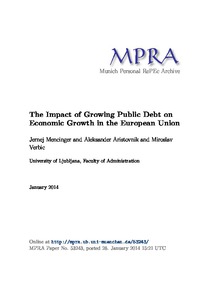The impact of growing public debt on economic growth in the European Union
"The paper attempts to empirically explore the transmission mechanism regarding the short-term impact of public debt and growth. We examine and evaluate the direct effect of higher indebtedness on economic growth for countries in the EU which are in the epicentre of the current sovereign debt c...
| Main Authors: | , , |
|---|---|
| Institution: | ETUI-European Trade Union Institute |
| Format: | TEXT |
| Language: | English |
| Published: |
Munich
2014
MPRA |
| Subjects: | |
| Online Access: | https://www.labourline.org/KENTIKA-19110779124919389519-The-impact-of-growing-public-d.htm |
| _version_ | 1771659897766674433 |
|---|---|
| author | Mencinger, Jernej Aristovnik, Aleksander Verbic, Miroslav |
| author_facet | Mencinger, Jernej Aristovnik, Aleksander Verbic, Miroslav |
| collection | Library items |
| description | "The paper attempts to empirically explore the transmission mechanism regarding the short-term impact of public debt and growth. We examine and evaluate the direct effect of higher indebtedness on economic growth for countries in the EU which are in the epicentre of the current sovereign debt crisis. In comparison to similar empirical studies, our research will add to the existing literature by extending the sample of countries and providing the latest empirical evidence for a non-linear and concave (i.e. inverted U-shape) relationship. The empirical analysis primarily includes a panel dataset of 25 sovereign member states of the EU. Our sample of EU countries is divided into subgroups distinguishing between so-called ‘old’ member states, covering the period 1980–2010, and ‘new’ member states, covering the period 1995–2010. In order to account for the impact of the level of the debt-to-GDP ratio on the real growth rate of GDP, we employ a panel estimation on a generalized economic growth model augmented with a debt variable, while also considering some methodological issues like the problems of heterogeneity and endogeneity. The results across all models indicate a statistically significant non-linear impact of public debt ratios on annual GDP per capita growth rates. Further, the calculated debt-to-GDP turning point, where the positive effect of accumulated public debt inverts into a negative effect, is roughly between 80% and 94% for the ‘old’ member states. Yet for the ‘new’ member states the debt-to-GDP turning point is lower, namely between 53% and 54%. Therefore, we may conclude that the threshold value for the ‘new’ member states is lower than for the ‘old’ member states. In general, the research may contribute to a better understanding of the problem of high public debt and its effect on economic activity in the EU." |
| format | TEXT |
| geographic | EU countries |
| id | 19110779124919389519_439a5f43aef64190967b97ea6bb724f3 |
| institution | ETUI-European Trade Union Institute |
| is_hierarchy_id | 19110779124919389519_439a5f43aef64190967b97ea6bb724f3 |
| is_hierarchy_title | The impact of growing public debt on economic growth in the European Union |
| language | English |
| physical | 1 v. Digital |
| publishDate | 2014 |
| publisher | Munich MPRA |
| spellingShingle | Mencinger, Jernej Aristovnik, Aleksander Verbic, Miroslav economic growth fiscal policy public debt The impact of growing public debt on economic growth in the European Union |
| thumbnail | https://www.labourline.org/Image_prev.jpg?Archive=109612492789 |
| title | The impact of growing public debt on economic growth in the European Union |
| topic | economic growth fiscal policy public debt |
| url | https://www.labourline.org/KENTIKA-19110779124919389519-The-impact-of-growing-public-d.htm |

